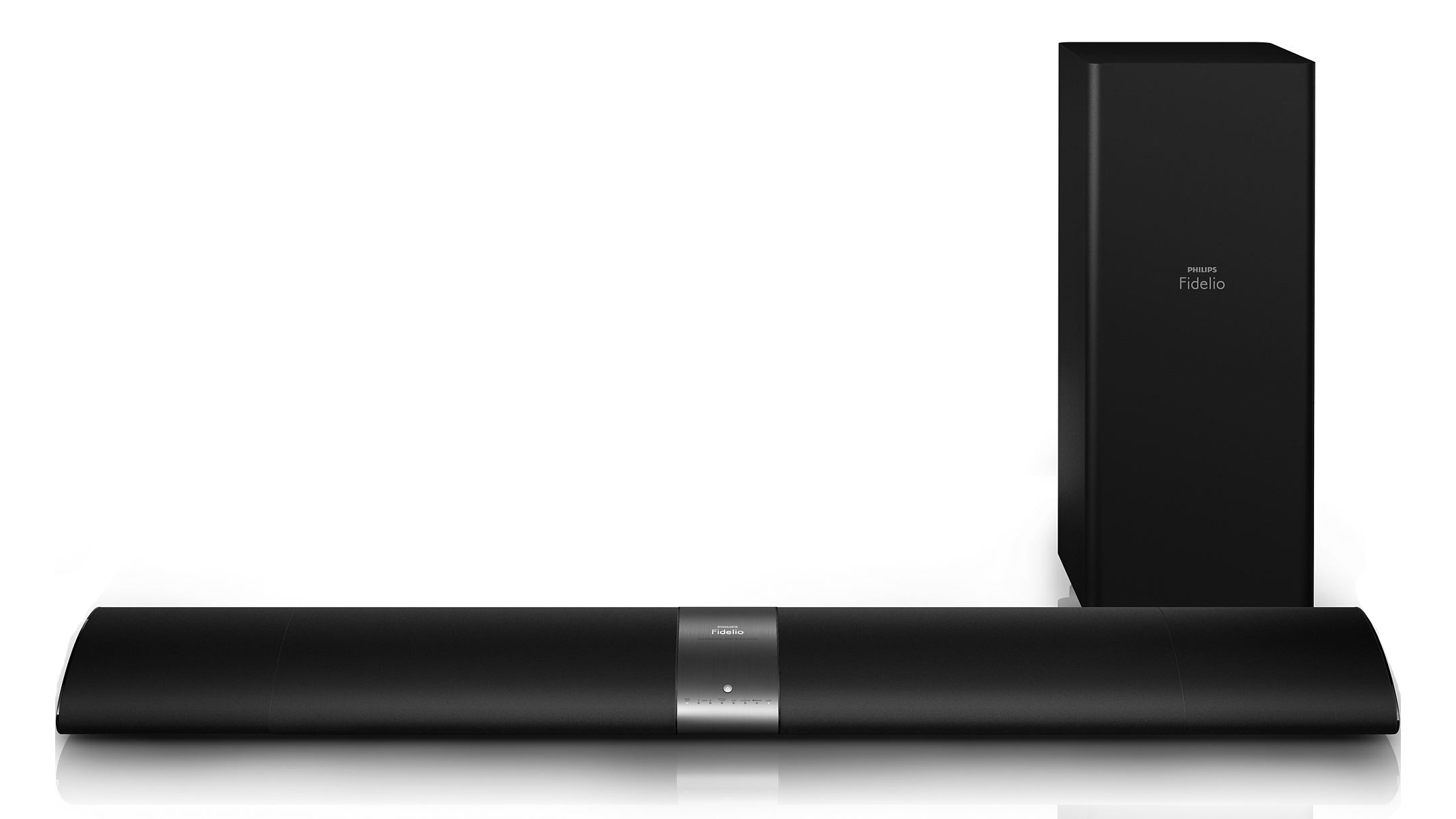TechRadar Verdict
Philips' stab at an all-in-one wireless wonder is a well-timed, even long overdue, innovation. Good-looking and easy to live with, the detachable Surround On Demand mode works enough wonders to make this soundbar worth shelling out for.
Pros
- +
Effective surround sound
- +
Wireless subwoofer
- +
Automatic switch virtual to surround
- +
Easy to set up
- +
Uncompressed audio
Cons
- -
Expensive
- -
Satellites need recharging
- -
Requires wide AV furniture
Why you can trust TechRadar
Fancy some home cinema action without the fuss and bother of separates? Philips' Fidelio HTL9100 is a one metre-wide 210W Bluetooth soundbar designed to sit underneath a TV (of the 46-inch size or so) to deliver either stereo or 'virtual' surround sound.
Nothing new there, though no other soundbar we know of has detachable satellite speakers on its ends. Slide off the two otherwise invisibly joined book-sized speakers and they instantly become rear-channel speakers - surround sound is suddenly created.
They're wireless, of course, and enable the kind of temporary home cinema setups that might just prove acceptable. Each satellite has a built-in battery that's good enough for about 10 hours - you might just about squeeze in a Lord of the Rings film fest if you leave out The Hobbit.
A subwoofer is in tow, too, though it's fairly inoffensive; it connects automatically, and wirelessly, to the main unit of the Philips HTL9100, though it must be powered.
The Philips soundbar is priced at £700 (around US$1,068/AU$1,198), making it more affordable than many rivals.
Features
The main soundbar has two 1-inch tweeters and two 2.5-inch mid range, while each satellite has one 2.5-inch driver. Those satellites, which fetch uncompressed audio from the main unit using a proprietary 5.8MHz wireless link, have preset levels that can't be tinkered with.
Aside from its novel surround sound duties, there are some residual features, too, such as Bluetooth wireless streaming. Using this connection, the Philips HTL9100 can very easily be paired with a smartphone or tablet for basic music playback.
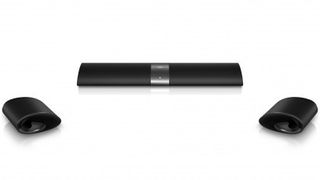
The Philips HTL9100 also works as an HDMI switcher. On its rear are two HDMI inputs (to hook up, say, a Blu-ray player and a set-top box) and one output (for attaching the soundbar to a TV), though there's also a set of phonos and both optical and coaxial digital audio inputs, principally for those wanting to use the tuner in their TV.
We didn't experience any lag, but the remote does contain an audio sync button just in case. One of those HDMI inputs is Audio Return Channel (ARC)-compatible, while the Philips HTL9100 can decode Dolby Digital and DTS codecs.
Performance
Setting up the Philips HTL9100 is purely a matter of choosing between stereo and virtual audio modes, though going between the two does involve a second or so of silence as the soundbar switches.
The curved pebble-like remote makes that child's play, while also containing control for bass and treble. That remote also has dedicated buttons for each audio input, as well as for volume.
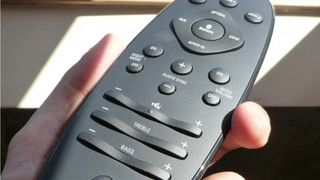
Transforming the Philips HTL9100 into a surround sound system is simply a matter of disconnecting those satellite speakers. Do so and a blue LED on each one lights up as it attempts to make a wireless connection with its mother-ship. Again, there's a second or so of silence as this takes place, and once done, both speakers spit out rear-channel sound effects.
It's worth pointing out that when in this configuration the Philips HTL9100's virtual mode is no longer an option - there's simply no need.
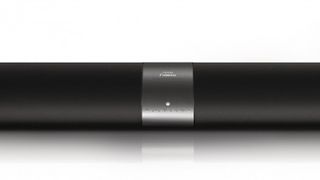
We would talk you through setting up the subwoofer, but there's very little to report - it's the ultimate in plug and play.
Surround on Demand is impressive. During Star Wars: A New Hope on Blu-ray, the background hum of the Death Star trenches helps create an enveloping experience, with loads of exacting, clinical detail. Even the virtual surround mode works wonders, with the soundstage wrenched open.
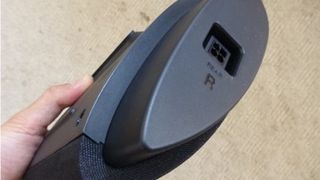
The Philips HTL9100 goes up to loud volumes without distorting, lending refined power to the closing sequences o the film - though it's arguably with the music over the credits that the Philips HTL9100 impresses us most.
Although the treble detailing is superb, the Philips HTL9100 is in huge debt to its wireless subwoofer, which never misses a beat in providing tight, dynamic low frequency to audio that impresses across the range.
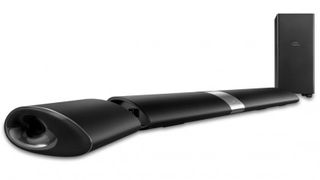
That's not to say that the Philips HTL9100 doesn't need a little time to settle in - as the levels of the satellites are preset to be fairly quiet, it's worth experimenting with their placements. It will depend on the movie, but during A New Hope we tended to want the satellites fairly close.
It's likely that your room will decide on placement - the need for ear-level surfaces probably means bookshelves and window sills.
Verdict
Hands up who still has home cinema speakers strewn around their living room? Not many, we'd wager, but Philips thinks that you secretly want to return to the days of 5.1 if only there was a way to ditch the cables and clutter.
We liked
A gyroscope that adjusts sound levels for those hanging the Philips HTL9100 on a wall is handy, though it's the simple set up that we loved most. Linking together the various elements and features of the Philips HTL9100 couldn't be easier - and that's despite there being no on-screen user interface.
In fact, we'd go so far as to say that it's almost completely idiot-proof. Attach the main unit to a TV, and a source to the Philips HTL9100, and you're good to go. Tear off the satellite speakers and surround sound is instantly created without any fuss. We also like the easy way those satellites slip back into their stereo charging position without any fiddling or force necessary.
The slim subwoofer isn't just painless to set up and live with, but it also helps the Philips HTL9100 to deliver awesome stereo and expansive surround sound that pushes clarity and detail, too. Even the virtual surround mode while in the one-piece array works well.
Lastly, the chance to listen to stereo music while in Surround On Demand mode is made possible by the presence of Dolby Pro Logic II - and it's with music that the Philips HTL9100 is most impressive, a characteristic that makes its Bluetooth streaming feature useful, too.
We disliked
Night Mode, which is supposed to quieten the Philips HTL9100, doesn't appear to do much. Meanwhile the 10 hours of battery life on each satellite speaker is reasonable, though it does restrict the surround sound feature to occasional use only.
Final verdict
Home cinema quality too often comes with cables galore, so Philips' stab at an all-in-one wireless wonder is a well-timed, even long overdue, innovation. It's so easy to set up it's unreal, while HDMI switching and Bluetooth streaming stretch its appeal.
Good-looking and easy to live with, the detachable Surround On Demand mode works enough wonders to make this soundbar worth shelling out for, though even in an all-in-one soundbar mode the Philips HTL9100 will add some serious welly to your TV.
Jamie is a freelance tech, travel and space journalist based in the UK. He’s been writing regularly for Techradar since it was launched in 2008 and also writes regularly for Forbes, The Telegraph, the South China Morning Post, Sky & Telescope and the Sky At Night magazine as well as other Future titles T3, Digital Camera World, All About Space and Space.com. He also edits two of his own websites, TravGear.com and WhenIsTheNextEclipse.com that reflect his obsession with travel gear and solar eclipse travel. He is the author of A Stargazing Program For Beginners (Springer, 2015),

9 of my favorite movies and shows that I streamed on Netflix, Prime Video and more in March 2025

ICYMI: the week's 7 biggest tech stories from Nintendo's last Switch direct to the Google Pixel 9a finally getting a release date

I tested this pocket-sized SSD for a week and now I take it everywhere with me
